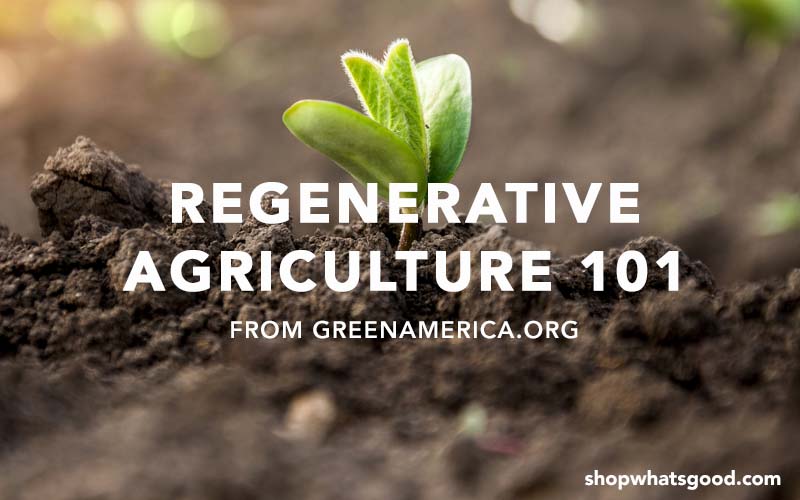FREE 🇺🇸 GROUND SHIPPING Orders 75+
FREE 🇺🇸 GROUND SHIPPING Orders 75+
Add description, images, menus and links to your mega menu
A column with no settings can be used as a spacer
Link to your collections, sales and even external links
Add up to five columns
Add description, images, menus and links to your mega menu
A column with no settings can be used as a spacer
Link to your collections, sales and even external links
Add up to five columns
Heal the Soil, Cool the Climate
August 16, 2022

Re-posted from Green America®, greenamerica.org
First published in Green American Magazine
"Healthy Soil, Cool Climate" Issue, Winter 2018
Written by Tracy Fernandez Rysavy
What is regenerative agriculture?
Regenerative agriculture is a holistic land-management practice that uses the power of photosynthesis in plants to sequester carbon in the soil while improving soil health, crop yields, water resilience, and nutrient density.
Why is regenerative agriculture important?
We are plunging into climate crisis. Regenerative agriculture draws down atmospheric carbon dioxide and, at scale, can reverse the climate crisis. We are about to run out of topsoil to grow food worldwide. Regenerative agriculture rebuilds top soil and, at scale, can provide global food security.
We are about to lose adequate water to sustain human societies. Regenerative agriculture recharges water cycles and restores water quality, and, at scale, can provide both drought and flood resilience.
Are “organic” and “regenerative” the same thing?
They are not the same, though organic and biodynamic have a huge head start. All forms of agriculture, including organic, can become more regenerative.
For sure, regenerative organic is the North Star, the ideal. At the same time, to reach the scale needed to get the benefits of soil health and carbon sequestration, it is urgent that everyone who touches soil becomes more regenerative. Organic is one percent of global agricultural acres, and regenerative organic is a small fraction of that. Regenerative agriculture also needs to reach the other 99 percent.
How do I advance regenerative agriculture?
- Plant a Climate Victory Garden at home or your community garden.
- Buy regenerative organic, biodynamic, or organic whenever you can.
- Move to a primarily plant-based diet. If you buy meat, make it organic, grassfed, or Land to Market (a certification for food that’s farmed regeneratively).
- Ask farmers, food companies, and retailers if the products they sell are rebuilding soil health and sequestering carbon. Everyone in the food system needs to hear that consumers care! Here are some questions to ask:
Ask farmers: Do you know if cover crops, crop rotations, and low tillage was used to grow this food? (If they don’t, send them to Green America’s explanatory page to get them started.)
Ask food companies and retailers: Do you require the producers who make your products to report to you on their soil health and carbon sequestration progress? (If they don’t, send them to Green America's Soil Carbon Initiative director at SCI@greenamerica.org.)
What are some regenerative agriculture practices?
The following farming and gardening practices help regenerate the soil:
Beginning practices include using cover crops, reducing tilling, rotating crops, spreading compost (as well as super-compost “inoculants”), and moving away from synthetic fertilizers, pesticides, herbicides, and factory farming.
More advanced farming practices include growing multi-species cover crops, integrating animals and crops, and introducing more trees and other perennial crops. Other advanced practices include silvopasture (the intentional combination of trees, forage plants, and livestock together as an integrated, intensively managed system) and agroforestry (the restoration of trees and tree crops on farms).
More advanced ranching practices include using adaptive multi-paddock (AMP) grazing, which uses high livestock densities for short durations between long periods for the land to rest and grow diverse grasses.
Everyone can regenerate their soil, even in your home garden! Learn more about Green America’s Climate Victory Garden campaign, which provides a version of regenerative practices just for gardeners.
- -
What's Good® is a Green America® Certified Green Business.
Leave a comment

Good News
If any email is worthy of your inbox, it's this. Our goal is 1–2x per month. You'll get helpful & inspiring eco info, plus subscriber-only discounts.
Welcome to What's Good
Here's your $10 coupon
COPY THIS CODE TO USE IN CHECKOUT
